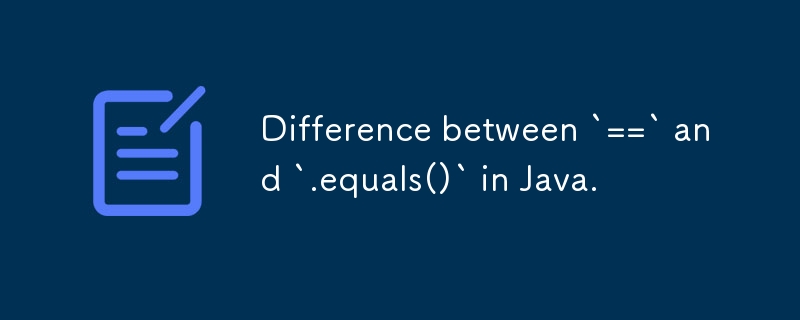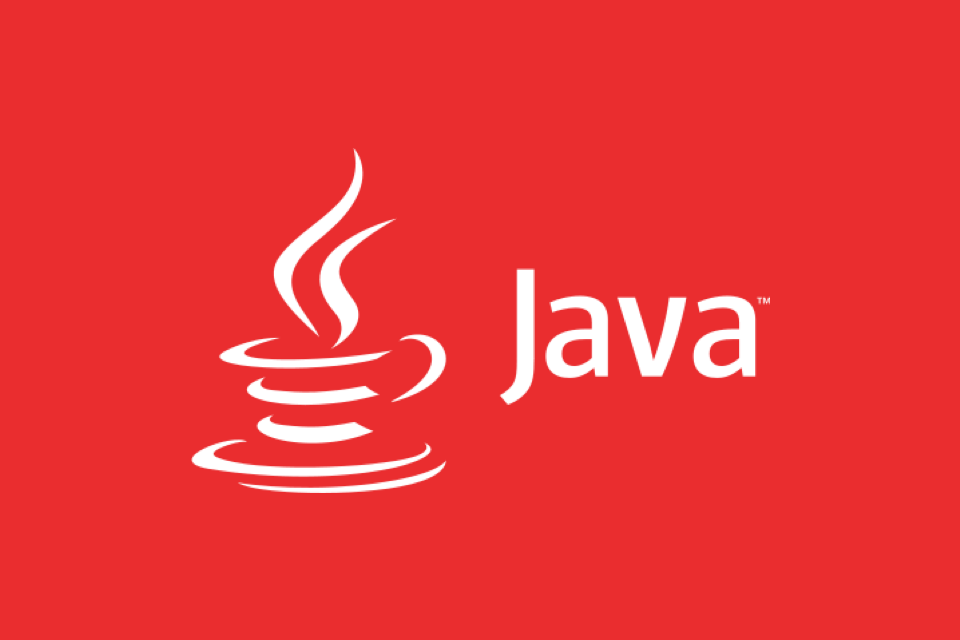In Java, the main difference between == and .equals() is the content of comparison: 1. == compares whether the object's reference points to the same memory address; 2. The default behavior of .equals() is the same as ==, but is usually rewritten to compare the content of the object. For example, the String class overrides .equals() to compare character sequences, and when using ==, it will return false due to different references. For basic types such as int, you can only use == for value comparison. In actual use, operators should be selected according to requirements: == when you need to determine whether two objects are the same instance, and .equals() when you need to compare logical values, and pay attention to handling null values to avoid exceptions.

In Java, the difference between == and .equals() comes down to what they compare: one checks if two references point to the same object in memory, while the other checks if two objects are logically equal based on their content.

== Compares References, Not Values
When you use == with objects in Java, it doesn't check the actual data inside the objects. Instead, it checks whether both variables refer to the exact same object in memory.

For example:
String a = new String("hello");
String b = new String("hello");
System.out.println(a == b); // false Even though a and b both contain "hello", they are two separate objects created with new , so == returns false .

This behavior is especially important when working with custom objects. Unless two variables point to the very same instance, == will return false .
.equals() Compares Object Content (Usually)
The .equals() method, by default, behaves the same as == . However, many classes — like String , Integer , and others — override this method to provide meaningful comparisons based on the internal state of the object.
Take this for example:
String a = new String("hello");
String b = new String("hello");
System.out.println(a.equals(b)); // true Here, .equals() compares the actual characters in the strings and returns true because both have the same value.
But keep in mind:
- If a class hasn't overridden
.equals(), it will still behave like==. - For custom classes, you'll need to override
.equals()yourself to get logical comparisons.
What About Primitive Types?
With primitive types like int , double , etc., there's no distinction — you always use == because primitives aren't objects.
int x = 5; int y = 5; System.out.println(x == y); // true
If you're using wrapper classes like Integer , then again, you should prefer .equals() for value comparison, unless you really want to check reference equality.
Practical Tips
-
Use
==when:- Comparing primitive types.
- Checking if two references point to the exact same object.
-
Use
.equals()when:- Comparing values of objects like
String,Integer, etc. - You want to know if two different objects represent the same logical value.
- Comparing values of objects like
-
Always be cautious with nulls:
-
someObject.equals(...)can throw aNullPointerExceptionifsomeObjectisnull. - Consider using
Objects.equals(a, b)fromjava.utilwhich safely handles nulls.
-
So the main thing to remember is:
== checks where an object is (memory address), while .equals() checks what the object contains (if implemented properly).
Basically that's it.
The above is the detailed content of Difference between `==` and `.equals()` in Java.. For more information, please follow other related articles on the PHP Chinese website!

Hot AI Tools

Undress AI Tool
Undress images for free

Undresser.AI Undress
AI-powered app for creating realistic nude photos

AI Clothes Remover
Online AI tool for removing clothes from photos.

Clothoff.io
AI clothes remover

Video Face Swap
Swap faces in any video effortlessly with our completely free AI face swap tool!

Hot Article

Hot Tools

Notepad++7.3.1
Easy-to-use and free code editor

SublimeText3 Chinese version
Chinese version, very easy to use

Zend Studio 13.0.1
Powerful PHP integrated development environment

Dreamweaver CS6
Visual web development tools

SublimeText3 Mac version
God-level code editing software (SublimeText3)

Hot Topics
 Difference between HashMap and Hashtable?
Jun 24, 2025 pm 09:41 PM
Difference between HashMap and Hashtable?
Jun 24, 2025 pm 09:41 PM
The difference between HashMap and Hashtable is mainly reflected in thread safety, null value support and performance. 1. In terms of thread safety, Hashtable is thread-safe, and its methods are mostly synchronous methods, while HashMap does not perform synchronization processing, which is not thread-safe; 2. In terms of null value support, HashMap allows one null key and multiple null values, while Hashtable does not allow null keys or values, otherwise a NullPointerException will be thrown; 3. In terms of performance, HashMap is more efficient because there is no synchronization mechanism, and Hashtable has a low locking performance for each operation. It is recommended to use ConcurrentHashMap instead.
 Why do we need wrapper classes?
Jun 28, 2025 am 01:01 AM
Why do we need wrapper classes?
Jun 28, 2025 am 01:01 AM
Java uses wrapper classes because basic data types cannot directly participate in object-oriented operations, and object forms are often required in actual needs; 1. Collection classes can only store objects, such as Lists use automatic boxing to store numerical values; 2. Generics do not support basic types, and packaging classes must be used as type parameters; 3. Packaging classes can represent null values ??to distinguish unset or missing data; 4. Packaging classes provide practical methods such as string conversion to facilitate data parsing and processing, so in scenarios where these characteristics are needed, packaging classes are indispensable.
 How does JIT compiler optimize code?
Jun 24, 2025 pm 10:45 PM
How does JIT compiler optimize code?
Jun 24, 2025 pm 10:45 PM
The JIT compiler optimizes code through four methods: method inline, hot spot detection and compilation, type speculation and devirtualization, and redundant operation elimination. 1. Method inline reduces call overhead and inserts frequently called small methods directly into the call; 2. Hot spot detection and high-frequency code execution and centrally optimize it to save resources; 3. Type speculation collects runtime type information to achieve devirtualization calls, improving efficiency; 4. Redundant operations eliminate useless calculations and inspections based on operational data deletion, enhancing performance.
 What are static methods in interfaces?
Jun 24, 2025 pm 10:57 PM
What are static methods in interfaces?
Jun 24, 2025 pm 10:57 PM
StaticmethodsininterfaceswereintroducedinJava8toallowutilityfunctionswithintheinterfaceitself.BeforeJava8,suchfunctionsrequiredseparatehelperclasses,leadingtodisorganizedcode.Now,staticmethodsprovidethreekeybenefits:1)theyenableutilitymethodsdirectly
 What is an instance initializer block?
Jun 25, 2025 pm 12:21 PM
What is an instance initializer block?
Jun 25, 2025 pm 12:21 PM
Instance initialization blocks are used in Java to run initialization logic when creating objects, which are executed before the constructor. It is suitable for scenarios where multiple constructors share initialization code, complex field initialization, or anonymous class initialization scenarios. Unlike static initialization blocks, it is executed every time it is instantiated, while static initialization blocks only run once when the class is loaded.
 What is the `final` keyword for variables?
Jun 24, 2025 pm 07:29 PM
What is the `final` keyword for variables?
Jun 24, 2025 pm 07:29 PM
InJava,thefinalkeywordpreventsavariable’svaluefrombeingchangedafterassignment,butitsbehaviordiffersforprimitivesandobjectreferences.Forprimitivevariables,finalmakesthevalueconstant,asinfinalintMAX_SPEED=100;wherereassignmentcausesanerror.Forobjectref
 What is type casting?
Jun 24, 2025 pm 11:09 PM
What is type casting?
Jun 24, 2025 pm 11:09 PM
There are two types of conversion: implicit and explicit. 1. Implicit conversion occurs automatically, such as converting int to double; 2. Explicit conversion requires manual operation, such as using (int)myDouble. A case where type conversion is required includes processing user input, mathematical operations, or passing different types of values ??between functions. Issues that need to be noted are: turning floating-point numbers into integers will truncate the fractional part, turning large types into small types may lead to data loss, and some languages ??do not allow direct conversion of specific types. A proper understanding of language conversion rules helps avoid errors.
 What is the Factory pattern?
Jun 24, 2025 pm 11:29 PM
What is the Factory pattern?
Jun 24, 2025 pm 11:29 PM
Factory mode is used to encapsulate object creation logic, making the code more flexible, easy to maintain, and loosely coupled. The core answer is: by centrally managing object creation logic, hiding implementation details, and supporting the creation of multiple related objects. The specific description is as follows: the factory mode handes object creation to a special factory class or method for processing, avoiding the use of newClass() directly; it is suitable for scenarios where multiple types of related objects are created, creation logic may change, and implementation details need to be hidden; for example, in the payment processor, Stripe, PayPal and other instances are created through factories; its implementation includes the object returned by the factory class based on input parameters, and all objects realize a common interface; common variants include simple factories, factory methods and abstract factories, which are suitable for different complexities.






